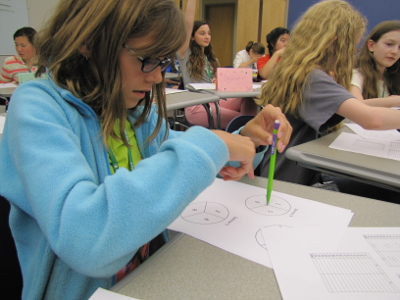
NIMBioS Education Module
Spinners! Probability and Transitivity
In this module, designed for grades 7-12, students explore probability and the relative property of transitivity. Transitivity can be used in any subject ranging from history to english to science to math. The most simplistic mathematical form of transitive property shows that if a=b and b=c, then a=c. This module will help show students that the transitive property has multiple facets, and does not always work as one expects.
Students may be introduced to the idea of transitivity using an example with people and their relationships. If Stephanie and Jessica are sisters and Jessica and Charlotte are sisters, are Stephanie and Charlotte sisters? Yes, they have a high likelihood of being sisters. If Joe and Peter are cousins and Peter and Jason are cousins, are Joe and Jason cousins? Not necessarily.
In pairs, students will compare outcomes from three spinners, two at a time. Then students will make a prediction about which spinner will "win" in the final round. Students may be surprised! The spinners are based on a popular game that some students can guess at the end.
Materials Needed: Paper clips, pencils, and worksheet
Worksheet File:
(.pdf)
Reference: Mullins B and Pollack D. 2002. Probability experiments for student investigation. Association for Women in Mathematics Newsletter 32(1):11-13.
Other NIMBioS education modules
For further information, please contact:
|
Suzanne Lenhart Associate Director for Education and Outreach Email: slenhart@tennessee.edu Ph: (865) 974-4270 (Math) (865) 974-9349 (NIMBioS) Fax: (865) 974-9300 | |
|
NIMBioS, 1122 Volunteer Blvd., Suite 106 University of Tennessee Knoxville, TN 37996-3410 | |
NIMBioS
1122 Volunteer Blvd., Suite 106
University of Tennessee
Knoxville,
TN 37996-3410
PH: (865) 974-9334
FAX: (865) 974-9461
Contact NIMBioS


